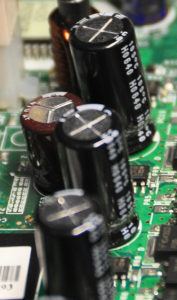Podcast: Play in new window | Embed
Keenan asked: “I was wondering if you could tell me how close we are to actually being able to implement supercapacitors into our everyday lives, such as cell phones or bluetooth speakers, so we no longer have to be limited by the batteries we have nowadays.”
Keenan, grab a chair, you have some waiting to do.
For those who don’t know, supercapacitors charge virtually instantly (think, a few seconds), and like all capacitors can store a charge. That sounds pretty great, but they’re mostly used for industrial applications where they’re expected to charge and discharge very often, and where they need to be charged and discharged very quickly, not as a real replacement for the chemical batteries we use for just about everything.
Whether you know it or not, you’ve all seen capacitors, they’re those things on PCB’s that look like a tiny battery on two skinny wires, or the ones that look like an M&M on two skinny, wiry legs. They store energy by charging two conductive plates separated by a dielectric, since they can not discharge by touching each other, they create an electric field between the plates. That happens very, very quickly, and they can discharge just as quickly. A supercapacitor basically does the same thing, but can handle a lot more energy.

Supercapcitors as they exist now can store less energy than a similarly sized battery, and they lose voltage linearly, whereas a normal chemical battery keeps a pretty steady voltage, it drops, but it’s an exponential discharge, not linear. Your electronics as they are designed now, assume reasonably constant voltage so they can deliver stable performance right up until they’re starved for power and they shut down.
Supercapacitors would be great in that they could be charged in seconds, but really, is that what we need? We like to sleep, and we usually sit down for long periods close to an outlet. Ultimately, more energy density, and a slow steady discharge works better for us than instant charge, but the need to plug in regularly to make up for the lower storage capacity and the linear discharge.
Supercapacitors would be great in that they could be charged in seconds, but really, is that what we need?
Think of supercapacitors as a Bugatti Veyron, it’s much more exciting than your Ford, and it can do 253 mph! Which is great, but at 253 mph the Veyron famously drains a 26 gallon tank in 12 minutes and burns through a set of very expensive tires in 15. Your boring, slow Ford can probably meet your needs much better, even if it’s far less exciting and cool.
Graphene might change what we can use supercapacitors for, but that’s likely decades away. For now, chem batteries are the best we have for our real world needs.
Besides, our Lithium Ion batteries are not so bad! These days you can fast charge a battery to a good three quarters of the charge in under an hour, researchers a few years ago built a proof of concept battery that could be charged to 70% in 2 minutes. It’s not seconds, but it seems very reasonable for most of us.


